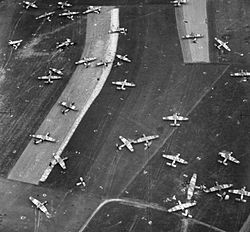Operation Mallard
| Operation Mallard | |||||||
|---|---|---|---|---|---|---|---|
| Part of the Normandy landings | |||||||
 Landing zone 'N' 7 June 1944 |
|||||||
|
|||||||
| Belligerents | |||||||
|
|
|
||||||
| Commanders and leaders | |||||||
|
|
|
||||||
| Units involved | |||||||
| 6th Airborne Division |
716th Infantry Division 21st Panzer Division |
||||||
Operation Mallard was the codename for an airborne forces operation which was conducted by the British Army on 6 June 1944, as part of the Normandy landings during World War II.
The mission's objective was to airlift glider infantry of the 6th Airlanding Brigade and divisional troops to reinforce the British 6th Airborne Division on the left flank of the British invasion beaches. Using two landing zones, one to the west of the Caen canal and the other to the east of the River Orne, Mallard was the third airborne operation involving units of the division on D-Day. The first, Operation Deadstick, had captured what are now known as the Pegasus and Horsa Bridges. Operation Tonga followed, dropping the division's two parachute brigades near Caen to the east.
Mallard proved successful with 246 of the 256 gliders towed by aircraft from No. 38 Group RAF and No. 48 Group, arriving safely at their landing zones. The landings included the first Tetrarch tanks to be delivered into combat by air.
Plans for the Normandy invasion included five assault landings from the sea, supported by airborne landings on both flanks by British and American airborne divisions. In what would be its first action, the 6th Airborne Division was chosen to land on the left flank of the British landing zone. Its primary objective on day one was to capture intact two bridges over the Caen canal and the River Orne. The division's secondary objective was the destruction of the Merville gun battery, which could engage ships landing nearby at Sword beach. To prevent German reinforcements approaching the invasion area from the east, 6th Airborne also had to destroy the bridges crossing the River Dives then dig in around Ranville and hold the left flank of the advance.
...
Wikipedia
